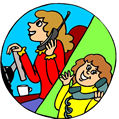1.2 Why do we
Write?
Let's look in on two scenes
involving two students at home on a Thursday night. As you read, think
about the different purposes of communication at different points in
the scenes.
| Sports
Talk |
 |
| Scene 1: Andy
is in his room, looking
through the newspaper's sports section. He is comparing his own track
team's record with the records of other teams in the league. The phone
rings. It's his friend and teammate, Tom. |
| Tom: |
Did you read the sports section today?
|
| Andy: |
Yeah. We're tied with Corinith for first
place now. We could win the whole league.
|
| Tom: |
Not if we don't put some different people
in our relays. When we go against Cornith at the end of the month,
they'll kill us in the relays.
|
| Andy: |
Maybe we'd better work more on the relays
in practice, then.
|
| Tom: |
Maybe we'd better eat more fast food, huh?
|
| Andy: |
Funny, Tom, real funny.
|
| Tom: |
Well, okay --so I'm not going to be a
great comedian. Speaking of entertainment, did you see the new Star
Wars movie? The special effects are amazing. I'm going to see it again
Saturday.
|
| Andy: |
I heard it's not as good as the first one,
but lets see it on Saturday.
|
|
 |
Homework Help
Scene 2: Tara's house. She is at the desk in
the den. She is just finishing her social studies homework. She closes
her book with a satisfied smile and reaches for the telephone. Before
she can pick it up, it rings. It's Mariella, a classmate. |
| Mariella: |
I need a break! I just finished the social
studies questions and now I have to do the paper for English.
|
| Tara: |
Hey, I just finished, too. I was just
going to call you when you called me --but I already finished the
English paper, ha-ha!
|
| Mariella: |
That's nice for you, but I don't even know
how to start the thing. That's really why I called you. How did you do
it? Did it take a long time?
|
| Tara: |
Not really. All you have to do is prove a
character in the story learned something from what happened in the
story. Look at the characters and compare what they're like at the
beginning and the end. Whoever changed the most must have learned
something, right?
|
| Mariella: |
I guess so. How long does it have to be?
|
| Tara: |
Only a page or so, but it has to be typed.
And it has to have quotations to back up your ideas.
|
| Mariella: |
That's it? Just show that a character
changed?
|
| Tara: |
Well, not quite. You also have to show how
the author reveals the change and how the change is important to the
meanings of the story.
|
| Mariella: |
That sounds like more than a one-page
paper to me.
|
|
Why do we Talk?
Now
let's look at the purposes for which these people talk with each other.
When Tom calls, Andy is reading the track results in the newspaper.
Their conversation begins with that topic. They are communicating to
get something done. Even though they're not professional athletes, we
can think of this as a "business" communication because they are trying
to make a decision to accomplish something with other people. They are analyzing
the results and planning their moves. The conversation involves critical
thinking and evaluation.
When the conversation shifts to jokes and
Star Wars, so does the purpose. This is a social conversation.
The boys are planning their entertainment. The tone of the talk is much
more casual.
When Mariella calls, she is looking for information.
She can't do her literature paper until she finds out what the
assignment is. There is also a social purpose here as she calls
her friend because she "needs a break."
As Tara explains the assignment, the conversation becomes literary.
She talks about text references (quotes), characterization (how the
author reveals the change), and theme (the meanings of the story).
Two short conversations involve four kinds of language use:
- Critical
- Social
- Informational
- Literary
We will explore these kinds of language use in more
detail in Section 1.3.
< Previous page
Table of Contents
Next page
>
|

